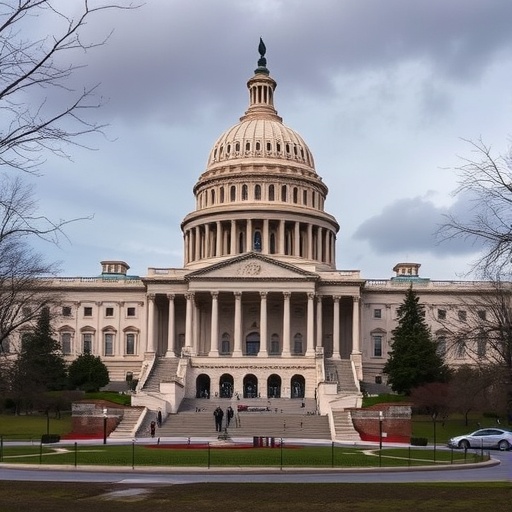Senate Stalls Funding Bill: 11th U.S. Government Shutdown Looms Over Federal Operations
In a dramatic late-night vote that sent shockwaves through Washington, the U.S. Senate failed to advance a critical funding bill, plunging the nation into its 11th government shutdown. Democrats, citing insufficient protections for vulnerable programs, blocked the Republican-led proposal, leaving federal employees and essential services in limbo as the clock ticked past midnight. This impasse highlights the deepening partisan divide, with no clear resolution in sight and millions of Americans bracing for the fallout.
Democrats’ Firm Stand Blocks Republican Funding Push
The Senate chamber, usually a bastion of deliberative governance, turned into a battleground as Democrats united to filibuster the funding bill proposed by Republicans. Senate Minority Leader Chuck Schumer (D-NY) delivered a scathing floor speech, declaring, “This bill is nothing more than a partisan ploy that shortchanges working families and ignores the real needs of our nation.” The measure, which aimed to extend government funding through the end of the fiscal year, included provisions for increased military spending but fell short on domestic priorities like healthcare subsidies and environmental protections, according to Democratic critics.
Republicans, led by Majority Leader Mitch McConnell (R-KY), countered that the bill represented a balanced approach in tough economic times. “We’re asking for fiscal responsibility, not extravagance,” McConnell stated in a post-vote press conference. The funding bill, clocking in at over $1.3 trillion, sought to avert the shutdown by maintaining current spending levels but included riders that Democrats viewed as poison pills, such as restrictions on immigration enforcement funding.
The vote tally was stark: 52-48 against advancing the bill, falling short of the 60 votes needed to overcome the filibuster. This procedural hurdle, a staple of Senate operations, amplified the gridlock. Behind the scenes, negotiations had dragged on for weeks, with both parties trading barbs over email and in closed-door meetings. Sources close to the talks revealed that a last-minute compromise on border wall funding was the sticking point, ultimately dooming the effort.
This isn’t the first time such a standoff has occurred. In the 2018-2019 shutdown, the longest in U.S. history at 35 days, similar disputes over immigration policy led to widespread disruptions. Today’s failure echoes that chaos, but with higher stakes given the ongoing economic recovery from the pandemic.
Federal Services Grind to a Halt in Shutdown’s Grip
As the government shutdown takes hold, the immediate impacts are rippling across the country. Non-essential federal operations are set to furlough approximately 800,000 employees, from park rangers in Yellowstone to IRS auditors in major cities. Essential services, including air traffic control, border security, and military operations, will continue, but at a reduced capacity that strains resources.
Statistics from previous shutdowns paint a grim picture. During the 2013 shutdown, which lasted 16 days, the U.S. economy lost an estimated $24 billion, according to the Congressional Budget Office. This time, with inflation concerns and supply chain issues lingering, experts predict even steeper costs—potentially exceeding $30 billion if the shutdown stretches beyond a week.
National parks, a hallmark of American heritage, face closure, denying access to over 300 million annual visitors. Smithsonian museums in Washington, D.C., will shutter their doors, affecting tourists and local economies. In the realm of science and research, the National Institutes of Health (NIH) will halt new patient enrollments in clinical trials, delaying breakthroughs in cancer treatments and vaccine development.
Federal financial aid programs are also at risk. The Small Business Administration (SBA) loans, vital for entrepreneurs, will pause approvals, potentially stifling job creation. Veterans’ benefits, while promised to continue via contingency funds, could face delays in processing, leaving many in uncertainty. One furloughed federal worker from Virginia shared anonymously, “I’ve been through this before—it’s stressful not knowing when your next paycheck comes. Families can’t keep planning around Washington’s games.”
- Key Affected Areas: National parks and monuments close to visitors.
- Federal lending programs, including student loans and disaster relief, suspend new applications.
- Food safety inspections by the FDA slow down, raising concerns over public health.
- Passport processing times extend, impacting international travel for thousands.
The human element underscores the shutdown’s toll. With over 2 million federal contractors also facing pay disruptions, the ripple effects hit communities hard, from military spouses in San Diego to scientists in Boston.
Historical Echoes: The 11th Shutdown in a Legacy of Partisan Standoffs
This marks the 11th government shutdown since 1976, when the modern budgeting process began, but the frequency has surged in recent decades amid polarized politics. The first notable shutdown in 1995-1996, under President Bill Clinton, stemmed from disputes over Medicare and welfare reform between Democrats and Republicans, lasting 21 days and costing $1.4 billion at the time.
Fast-forward to the Obama era, and shutdowns became a weapon in budget battles. The 2013 episode, triggered by the Affordable Care Act’s rollout, saw House Republicans demand defunding of Obamacare, leading to a 16-day halt that furloughed 850,000 workers. Under President Trump, shutdowns were even more acrimonious; the 2018-2019 event over wall funding affected 800,000 employees and delayed tax refunds for millions.
Now, in a Biden administration navigating post-COVID recovery, the dynamics have shifted but not softened. The funding bill’s failure reflects broader tensions: Republicans pushing for spending cuts amid rising deficits, while Democrats advocate for investments in infrastructure and social safety nets. According to a Pew Research Center analysis, public approval for Congress dips below 20% during shutdowns, eroding trust in institutions.
Olson, a political historian at Georgetown University, noted, “These shutdowns aren’t anomalies; they’re symptoms of a broken system where compromise is vilified. The 11th one signals that without electoral pressure, little changes.” Data from the Office of Management and Budget shows shutdowns have occurred 20 times since 1977, with durations averaging 7.5 days, but the psychological impact lingers longer.
In this context, the current Senate impasse isn’t isolated. It ties into larger debates on the debt ceiling, upcoming midterms, and Supreme Court nominations, where both Democrats and Republicans are jockeying for position.
Partisan Fireworks: Quotes and Reactions from Capitol Hill
The air in Washington crackled with rhetoric as leaders from both sides unleashed their frustrations. President Joe Biden, addressing the nation from the White House Rose Garden, urged unity: “This shutdown is unnecessary and harmful. I call on Congress to pass a clean funding bill without delay—our people deserve better than this dysfunction.” His words resonated with Democrats, who framed the Republican proposal as ideologically driven.
On the Republican side, House Speaker Kevin McCarthy (R-CA) blamed Democrats for obstructionism. “The Senate Democrats are holding the government hostage over extreme demands,” he said in a Fox News interview. “We’re ready to fund the basics; they’re playing politics.” Senate Republicans echoed this, with Sen. Lindsey Graham (R-SC) tweeting, “Democrats own this shutdown. Time to get serious.”
Moderate voices attempted bridge-building. Sen. Susan Collins (R-ME), a frequent bipartisan player, co-sponsored an amendment for balanced cuts but lamented its rejection. “We need to rise above party lines,” she told reporters. From the Democratic flank, Sen. Kyrsten Sinema (I-AZ), known for her independent streak, voted with Republicans but expressed disappointment: “This bill wasn’t perfect, but shutdowns hurt everyone.”
Public reaction, gauged by early polls from Gallup, shows 55% blaming both parties equally, with frustration peaking among independents. Advocacy groups weighed in too: The U.S. Chamber of Commerce warned of economic drag, while the AFL-CIO rallied for workers’ protections. These voices amplify the stakes, turning a procedural vote into a national spectacle.
Media coverage has been relentless, with CNN and MSNBC focusing on Democratic grievances and Fox News highlighting fiscal conservatism. Social media buzzes with hashtags like #EndTheShutdown, underscoring the story’s viral potential.
Path Forward: Negotiations Resume Amid Economic Warnings
As dawn broke over the Capitol, House and Senate leaders scheduled emergency talks, signaling a potential thaw. Bipartisan working groups, including the Problem Solvers Caucus, are convening to draft a revised funding bill, possibly stripping contentious riders to secure passage. Analysts predict a short shutdown—perhaps 3-5 days—if cooler heads prevail, but prolonged gridlock could force emergency measures like debt ceiling hikes.
Economists from the Brookings Institution forecast that each day of shutdown erodes GDP by 0.02%, compounding inflation pressures. The Federal Reserve may adjust interest rate plans, wary of volatility. For federal workers, backpay is assured post-resolution, but the uncertainty fosters anxiety; employee assistance programs are ramping up counseling services.
Looking ahead, this episode could influence the 2024 elections, with voters punishing perceived intransigence. Bipartisan bills on infrastructure, already passed, offer a template for success, but trust remains fragile. International allies watch closely, as U.S. unreliability affects global markets and diplomacy.
In the coming hours, expect shuttle diplomacy between the White House and Capitol Hill. A breakthrough might come via a continuing resolution (CR), a stopgap measure to buy time. Yet, without addressing root causes like budgeting reforms, the cycle of shutdowns may persist, testing the resilience of American democracy. For now, the nation holds its breath, hoping for resolution before the economic and human costs mount further.








